Grand Theft Auto 3 - Part I
by OldGamesCracking
Game Specs
| Name | Grand Theft Auto 3 |
|---|---|
| Release-Date | 05/2002 |
| Redump ID | 9700 |
| Protection | SafeDisc v2.51.021 + CD-Checks |
| Cracked under | Win XP + Win 10 |
| Tested under | Win 10 |
| Scene-Crack by | DEVIANCE / MYTH |
Needed Tools:
- Good Old PC (Windows XP)
- x32dbg
- ProcMon 3.1 (Win XP compatible)
- PE tool of your choice (e.g. PE-bear)
- Gimp :)
- The original Game-CD of course ;)
- Lots of sleepless nights
- Luca D’Amico whote wrote a nice Paper on the topic which I partly used as inspiration.
Disclaimer
- The games are cracked for educational purpose and to regain compatibility with modern systems
- The games are more than 20 years old and can be found freely on the net via e.g. archive.org
- No parts of the game are distributed
How to Crack
After I had dived into GTA 2 I thought I might have a look into GTA 3 as well. As you can read on the net, it seems to use SafeDisc v2.5, so we’ll see how this differs from the previous versions.
As always, open the Game in x32dbg (disable ScyllaHide and pass all exceptions) and have a look around. We are instantly detected, but that was no surprise:
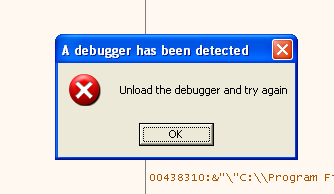
If we are lucky, they did not change the detection scheme since SafeDisc v1. So let’s try the script from last time:
; Start script at ep
bpd
bphc
$peb_addr = peb()
byte:[$peb_addr + 2] = 0
$addr_NtQueryInformationProcess = NtQueryInformationProcess
$addr_CreateProcessA = CreateProcessA
$addr_CreateFileA = CreateFileA
bphws $addr_NtQueryInformationProcess, x, 1
bphwcond $addr_NtQueryInformationProcess, "arg.get(1)==7"
SetHardwareBreakpointSilent $addr_NtQueryInformationProcess, 1
bphws SetThreadContext, x, 1
bphws WriteProcessMemory, x, 1
bphws ResumeThread, x, 1
SetHardwareBreakpointSilent SetThreadContext
SetHardwareBreakpointSilent WriteProcessMemory
SetHardwareBreakpointSilent ResumeThread
loop:
erun
cmp eip, $addr_NtQueryInformationProcess
jne end
$pi = dword:[esp+0x0C]
rtr
dword:[$pi] = 0
jmp loop
end:
So the script hides the debugger from PEB-checking and NtQueryInformationProcess and breaks on the first call to either SetThreadContext, WriteProcessMemory or ResumeThread which were the interesting ones last time.
The disc spins up it does some readings and after about 10 seconds, we break in ResumeThread which is kinda unexpected since that means that the Game process is already up and running.
By snooping around a bit, I discovered, that there does not seem to be an ICD file anymore (ICD = encrypted game in separete file) and also some strange temporary files are created. I guess it’s time for Process Monitor (Procmon). The current version does not seem to work under Win XP but version 3.1 seems to work well enough. I played a bit with the filters to reduce the noise and then it started to give a clearer image:

So it seems that a temp file is created that is read from the gta3.exe starting at offset 2,811,727 (0x2AE74F). The file is 515,600 bytes in size and is extracted in chunks of 2kb. Having a look with a hex editor at location 0x2AE74F in gta3.exe reveals that the data seems to be encrypted and is decrypted in memory. The temp file itself turns out to be a DLL and as we can see from the imports, the original name seemed to have been SecServ.dll so this is probably part of the SafeDisc driver.

Another file is created in the same manner:

Judging by the strings in the file and the fact that this file will not be removed after the game closes, I get the feeling it’s some kind of cleanup worker that removes the temp files, so we will call it worker.exe from now on:

A third file is opened, but nothing gets written to it. My guess is that this is just a dummy file that is monitored by the worker and when the game closes, Windows will release the handle automaticly, until then the worker can not access the file which signals to it that the game is still running.
Then worker.exe is started. More files (SECDRV.SYS and DrvMgt.dll) are created and data is written to them. And finally, a fourth file with a temp name is created. Judging from the info we find in our PE tool, the original name was AuthServ.dll and you can find many “please insert CD” strings in it. So this has all to do with interacting with the disc.
Next, multiple files from the disc are opened:
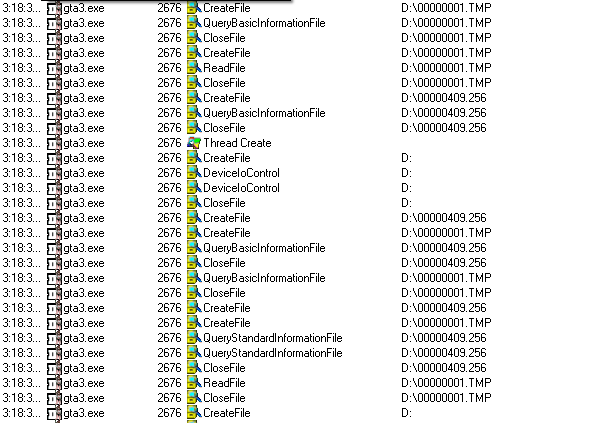
The 00000001.TMP file seems to contain encrypted binary data. The other files are bitmaps and contain the logo that is displayed once the game starts. Interestingly they all contain some small artifacts at different locations which I don’t know the reason for yet.

The first 28 bytes from 00000001.TMP are read and a threat is created. Then the disc drive is constantly read at various locations, so at that moment the disc is probably checked for authenticity (you can monitor some SCSI commands). Afterwards the thread is closed, so the check routine probably ran in a background thread. Shortly afterwards you can see that the game reads stuff that GTA-fans may recognize:

So, this in theory means that we never left gta3.exe like we did with SafeDisc v1 and no new process was created. This means that the OEP must be somewhere in the current process. Time to figure out where. So we need what I call an ‘anchor’ - a known location that will at least tell us that we are past the loader and within the game code. If the anchor stops execution we don’t know how far we are in the code, but at least we get a feeling of where the OEP might be.
So as a first rough start, let’s use the famous gta3.img and break once we have a CreateFile containing that location. For that we can use the script from GTA 2 and just change the name and function. But I was having a hard time and it did not break. After a few minutes of struggling and thinking I thought I solved the first part of the problem: stupid wide-char strings :D So we need to use CreateFileW. But then again, I could not break on gta.img, although peds.col (the second file that is loaded) worked fine and in contrast the file is also opened via CreateFileA, so where is gta3.img !?! So far, I have no freakin idea :D Let’s use ped.col then. (As it later turned out - at least that’s what I think, ProcMon shows the real filenames on disc not the strings that were passed to CreateFile. So if the program requests GTA3.IMG (uppercase), ProcMon still shows the name from disc - hence gta3.img. I think I could have used stristr to solve that issue).
bpc
bphwc
$addr_CreateFileA = CreateFileA + dis.len(CreateFileA)
bphws $addr_CreateFileA
bphwcond $addr_CreateFileA, "strstr(utf8(arg.get(0)), \"peds.col\") == 1"
$peb_addr = peb()
byte:[$peb_addr + 2] = 0
$addr_NtQueryInformationProcess = NtQueryInformationProcess
bphws $addr_NtQueryInformationProcess, x, 1
bphwcond $addr_NtQueryInformationProcess, "arg.get(1)==7"
SetHardwareBreakpointSilent $addr_NtQueryInformationProcess, 1
loop:
erun
cmp eip, $addr_NtQueryInformationProcess
jne end
$pi = dword:[esp+0x0C]
rtr
dword:[$pi] = 0
jmp loop
end:
Anyways, with the script above we finally break within the game and have a look at unobfuscated code. We can climb up the call stack a few times and see some interesting strings on the stack one of them being “-vms”. I have absolutely no Idea what that means but it sounds like a switch that is passed to the game which got me thinking that GetStartupInfoA might be a good place to break next in order to climb our way back to the OEP. I had to break at the 4-th hit:
bpc
bphwc
$addr_GetStartupInfoA = GetStartupInfoA + dis.len(GetStartupInfoA)
bphws $addr_GetStartupInfoA
bphwcond $addr_GetStartupInfoA, "$breakpointcounter >= 4"
$peb_addr = peb()
byte:[$peb_addr + 2] = 0
$addr_NtQueryInformationProcess = NtQueryInformationProcess
bphws $addr_NtQueryInformationProcess, x, 1
bphwcond $addr_NtQueryInformationProcess, "arg.get(1)==7"
SetHardwareBreakpointSilent $addr_NtQueryInformationProcess, 1
loop:
erun
cmp eip, $addr_NtQueryInformationProcess
jne end
$pi = dword:[esp+0x0C]
rtr
dword:[$pi] = 0
jmp loop
end:
Stepping out and looking around, we start to realize that we are already quite close:

The push ebp at the top and the nops before that look like a classic Entry Point. So we write that down: 0x005C1E70 and add a “bphws 0x005C1E70, x, 1” to the script.
Restart and - booom :) We are there ;)
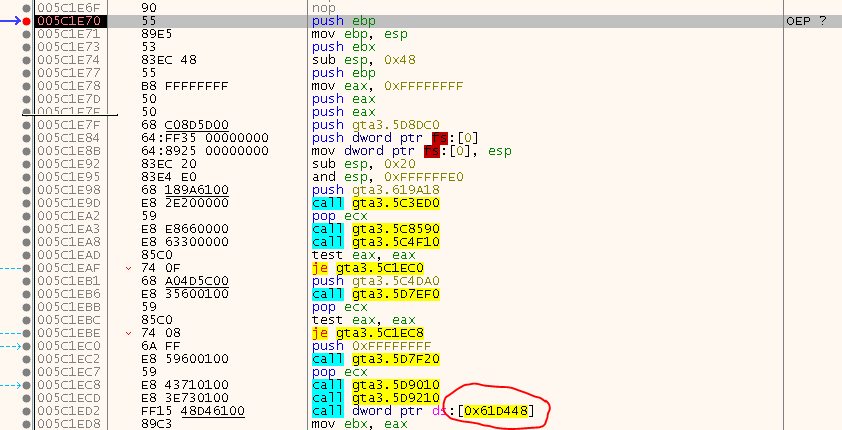
Well, that was kinda easy. Time for the fun part: fixing the IAT.
By the way, you can make a snapshot of the VM now so you can save on the time that the loader needs to load the data from the CD and also spare your drive from this jittery SafeDisc thing and you could also remove the CD now, at least for fixing the IAT. Thanks to Luca D’Amico / Antelox for that trick.
Ok, let’s have a closer look at the imports. In the image above we can already see a remote call. Step into that call and we see the following code:

Not exactly the same as SafeDisc 1 but kinda similar. If you try to step over the call, bad things happen. There are probably timing checks in there and the return address is probably checked for a 0xCC to detect a snoopy cracker ;) … at least that’s what I thought first, but it turns out that the problem is that the CALL actually never returned where I thought it would (address 0019992D0 in the image), all this “popad, popfd” was probably only added to confuse us, this code is never reached. In order to figure out the actual remote call address and how we return, this is what I did:
I single stepped past the pushfd and placed a hardware breakpoint on the top of the stack. Then hit F9 and landed here:
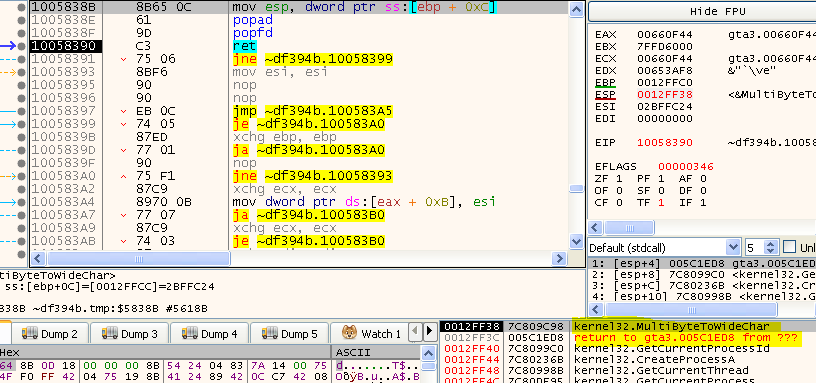
See how the address of the procedure that we actually tried to call is on the stack? If we return now, we land in that procedure. And the original return address is also there. Ok, this seems repairable:
- Go through the IAT and check for addresses that are in user sections (I used < 0x21100000)
- Place a HW BP ‘on access’ on the stack once the first value is pushed
- Run freely and then the BP will trigger two times (the first time is when the function address is written)
- We should be in the procedure and can retrieve its address
$iat_start = 0x0061D3B4
$iat_size = 0x000002D4
bpc
bphwc
$iat_end = $iat_start + $iat_size
$fixed = 0
$eip_org = eip
$esp_org = esp
loop:
; Always restore stack first
esp = $esp_org
cmp $iat_start, $iat_end
je end
$target = dword:[$iat_start]
cmp $target, 0
je next
cmp $target, 0x21100000
ja next
$rva = $iat_start - mod.main()
; Check if reachable
cmp mem.valid($target), 1
jne next
; Check if import routine -> has 'pusfd' as second instruction
$second = $target + dis.len($target)
$isimport = streq(dis.mnemonic($second), "pushfd")
cmp $isimport, 1
jne next
; Execute that routine
eip = $target
; Note: x32dbg sometimes swallows an sti right after eip has changed, so we use a BP instead
bp $second
erun
bpc $second
; Place HW BP on stack so we break right in function later
$hw_bp = esp
bphws $hw_bp, r
erun
; The address is not written to the stack, you will find the value in EDX
erun
; We should be in the real function now
bphwc $hw_bp
$fixed += 1
log "Fix #{u:$fixed}: VA:{p:$iat_start}, RVA:{p:$rva} -> {p:$target} ->{p:eip}"
dword:[$iat_start] = eip
next:
$iat_start += 4
jmp loop
end:
esp = $esp_org
eip = $eip_org
This works well and the imports are all fixed, but once we start the game, it crashes. I tried to track down the cause and realized that some imports were different to the original. So it looks like we either tripped a tripwire and SafeDisc will mess up the imports if we call them out of order or there is some setup going on that we miss. Let’s check. The particular CALL that is messed up is the one at 0x005C85B8. Normally it should call InitializeCriticalSection but it was resolved to WriteFile by the script.
In order to address the issue, I modified the script to only resolve that function (not the whole IAT) and it also returned WriteFile, so it looks like the order is not important, but we might miss some setup step. Maybe SafeDisc expects us to call one particular function first that they injected in the game code. After some minutes of poking in the dark and testing different things I found out that the return address on the stack seems to play an important role. Well, that means we need to find a corresponding CALL for every freakin’ thunk… ooouf!
Let’s try if we can pull that off with a script…
- Go through the IAT and select the addresses that goes to a stub (idientified via the address-range [within user code])
- Find a CALL to that stub via a searchpattern
- Push the return address of that CALL on the stack
- Modify EIP to point to the stub
- Use the pushfd trick from above to break in the remote procedure
- Fix the thunk by checking if we know the remote procedure already or if we need to add it to the IAT
- Cleanup. Done ;)
During the writing of the script I realized that the calls are not unique. Multiple CALLs seem to share the same stub but end up in a different remote procedure. The only common thing is the call to the function at 0x10057CE0 which I have called ‘Resolver’ and which we will see again later ;)
The Resolver is one hell of a mess and I tried to reverse it but gave up since there are tripwires everywhere and the control flow is fucked up, also the tripwires are silent so sometimes you just end up in a valid but different remote procedure. At one point I decided to just blackbox it.
That makes things slightly more complicated :( Looks like we also have to patch the CALLs itself to point to the right thunk in order to prevent collisions. But the problem is, where do we put the collided thunks? Well, my first approach was to simply use the empty thunks and hope for the best ;)
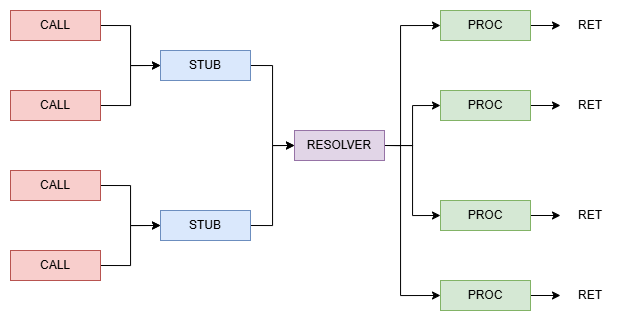
So in order to make that happen, we need to modify the script so that it will find all CALLs associated with a given thunk not just a single one.
The script ran fine up to a certain point and the imports were restored but from time to time the game crashed completely or exited while the script was still running. I spent a fair amount of time tracking down the cause and I still don’t know the real cause but while searching for similarities amongst the imoprts that were crashing, I discovered, that every crashing import had a CALL that was directly located below a RET.
Either they are fake-Calls that deliberately crash upon using the Resolver on them, probably placed in the empty space that some linkers leave between compilation units, or they serve internal purposes to SafeDisc. Or maybe these were once some kind of Unit-Testing thingies or some guards or whatever but the underlaying library was removed so the Resolver is unable to find the proc addresses… who knows, I did not dig deeper into that.

Also x32dbg could not find any execution paths to these strange CALLs (at least the one I checked), so I gave it a shot and simply ignored every CALL with RET in front of it:
$iat_start = 0x0061D3B4
$iat_size = 0x000002D4
bpc
bphwc
$iat_start_org = $iat_start
$code_base = mem.base(eip)
log "Code base: {p:$code_base}"
$iat_end = $iat_start + $iat_size
$fixed = 0
$eip_org = eip
$esp_org = esp
loop:
; Always restore stack first
esp = $esp_org
cmp $iat_start, $iat_end
je end
$target = dword:[$iat_start]
cmp $target, 0
je next
cmp $target, 0x21100000
ja next
$rva = $iat_start - mod.main()
; Check if reachable
cmp mem.valid($target), 1
jne next
; Check if import routine -> has 'pusfd' as second instruction
$second = $target + dis.len($target)
;$isimport = streq(dis.mnemonic($second), "pushfd")
;cmp $isimport, 1
;jne next
; Clear the thunk slot for later
dword:[$iat_start] = 0
; Find a CALL to that routine
findasm "call [0x{p:$iat_start}]", $code_base
$call_count = $result
cmp $call_count, 0
je next
$call_id = 0
process_calls:
cmp $call_id, $call_count
je next_fixed
$call_from = ref.addr($call_id)
log "Call from {p:$call_from}"
; Check if there is a 'ret' in front of the call
cmp byte:[$call_from - 1], 0xc3
jne not_ignored
jmp next
not_ignored:
; Put the return address on the stack
esp -= 4
dword:[esp] = $call_from + dis.len($call_from)
; Execute that routine
eip = $target
; Note: x32dbg sometimes swallows an sti right after eip has changed, so we use a BP instead
bp $second
erun
bpc $second
; Place HW BP on stack so we break right in function later
$hw_bp = esp
bphws $hw_bp, r
erun
; The address is now written to the stack, you will find the value in EDX
erun
; We should be in the real function now
bphwc $hw_bp
$func_address = eip
; Do we have this thunk already?
$search_iat_start = $iat_start_org
$search_iat_end = $search_iat_start + $iat_size
search_thunk:
cmp $search_iat_start, $search_iat_end
je thunk_not_found
cmp dword:[$search_iat_start], $func_address
jne next_thunk
; log "Thunk already in use at {p:$search_iat_start}"
dword:[$call_from + 2] = $search_iat_start
jmp search_thunk_done
next_thunk:
$search_iat_start += 4
jmp search_thunk
thunk_not_found:
; Search for an empty slot
$search_iat_start = $iat_start_org
$search_iat_end = $search_iat_start + $iat_size
search_empty_slot:
cmp $search_iat_start, $search_iat_end
je error_import
cmp dword:[$search_iat_start], 0
jne next_slot
; log "Empty slot at {p:$search_iat_start} used"
dword:[$call_from + 2] = $search_iat_start
dword:[$search_iat_start] = $func_address
jmp search_thunk_done
next_slot:
$search_iat_start += 4
jmp search_empty_slot
search_thunk_done:
$call_id += 1
jmp process_calls
next_fixed:
$fixed += 1
log "Fix #{u:$fixed}: VA:{p:$iat_start}, RVA:{p:$rva} -> {u:$call_count} Call(s) fixed"
next:
$iat_start += 4
jmp loop
error_import:
log "Could not find thunk"
end:
esp = $esp_org
eip = $eip_org
What a monstrosity of a script… (and yet tiny, compared to what will follow)
After the script finally passed without crashing I dumped and fixed the game just to discover that it still crashes on me. I tracked down the cause and landed on this strange thing:

A JMP to some quite far away portion of the memory, the code there looks something like that:

So basically it first retrieves EIP via the CALL to the next line (CALL +0) and then gets the address of a stub and places it on the stack to jump there via a return. The stub looks just like we know it:

It’s like the other stubs, just with an additional return address in front of it. So this is some kind of jump pad code that ends up in a stub and finally in the Resolver:

It looks like the stub is for one specific JMP in the code. That makes things easier this time.
So how does the script look like?
- Find the extended stub (stub with return address) via a searchpattern
- Subtract 6 from the return address to get the original jump location
- Maybe do a sanity check, to see if there really is a JMP
- Get the address of the remote procedure just as before
- Get the slot in the IAT just as before
- Replace the JMP with a CALL
That was rather straight forward and worked without any hassle. Time to start the game… and it crashed. Dammit! What’s the cause this time?
Turns out, SafeDisc has a third Ace up it’s sleeve: The Jump Pad Driven, Byte-Stealing, Self-Aware Stub (JPDBSSAS) :D
This one took nearly four days to solve and is the most whacky/hacky part of the script, also because x32dbg has - at the time of the writing - some bugs I had to maneuver around, but well, it gets the job done ;)
Enough talk, let’s see some code.
At - for example - 0x0048C0BD you find a call to a routine that looks like the following:

This is a tiny jump pad that will just put an address on the stack and jump there via a RET. So far, nothing special. At the address we see:

This looks and behaves pretty much as the Resolver before, only that I got quite confused on to where it will resolve to. It turned out, that it resolves to the address of the jump pad we just came from but it had altered (decrypted) the code so that the jump pad was replaced with the real code now (compare the addresses in the image):

Well, that seemed labor intensive but easy enough I thought, I just had to:
- Go through all regular CALLs in the program (Pattern “E8”, jep, just 1 byte)
- Check the code at the CALL destination and see if it resembles the jump pad (jep, make sure to include different registers [I think two are actually used])
- Proceed as above to exit the Resolver and land in the user code
- Done ;)
Well, yes, that works exactly one time and then things go south :( After some while I realized that once we land back in user-code, the return value on the stack points back to the Resolver. That means that - for whatever reason - the Resolver wants to have a second look at things. Well, how bad can it be to place a BP at the original return address and let the Resolver do it’s Resolver thingies? Answer: Quite bad :D
Turns out, now the Resolver was not crashing anymore and the script ran fine, but the code gets re-scrambled again by the Resolver and the jump pad is back O.o
So something like that:

Now comes the challenge: How can we re-construct the code if we must pass execution back to the Resolver but this will ultimately fuck things up again?
Well, let’s try the following:
- Let the Resolver unscramble the code
- Intercept the jump back to the code just as before (BP on pushfd)
- Copy the unscrambled code
- Instantly return via a “eip = [esp]; esp += 4”
- Place BP on the original return address, run and break there
- Overwrite now re-installed jump pad with copied code
- Done
Sounds easy and straight forward, right? Well, there is one samll detail: No one ever told us how many bytes to copy and the information seems nowhere around :(
In order to obtain that information I placed a HW BP on ‘write’ on the first byte of the scrambled code (the jump pad) hoping to land in a loop in the Resolver that would iterater over some control variable. I had to break multiple times since the code seems to be unscrambled in multiple passes, but then I found something:
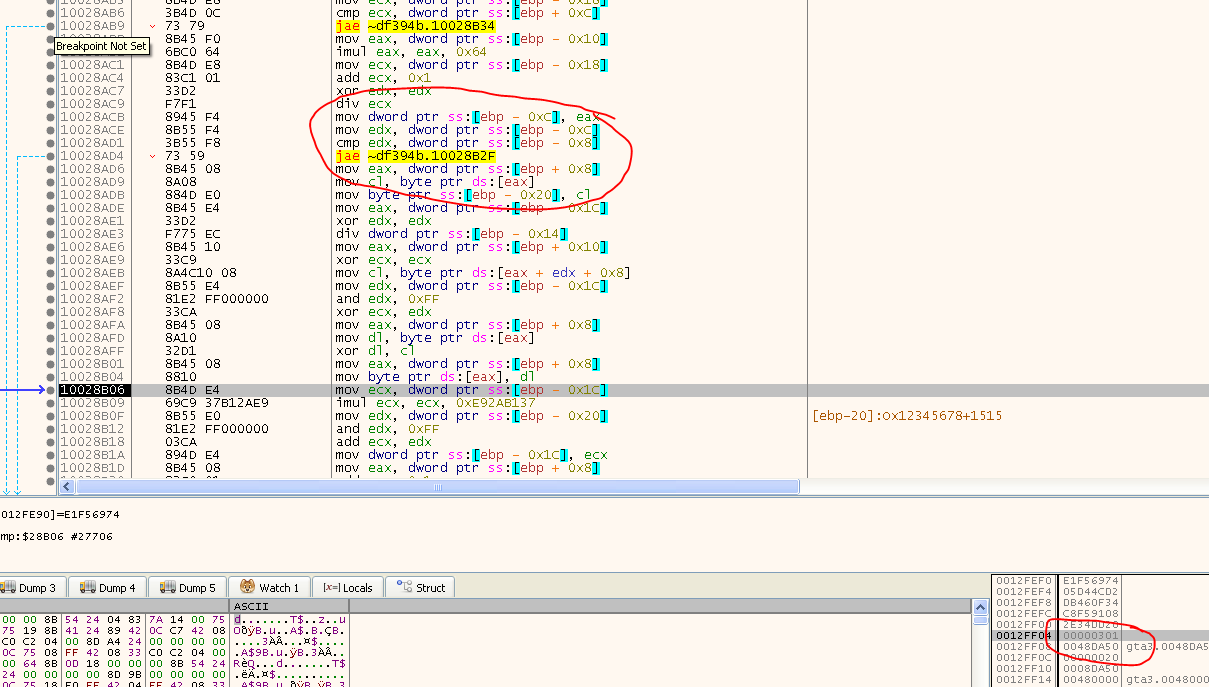
The CMP is what we were looking for. Strangely, when you run the Resolver for a given stub the first time, this value only holds a quite small value (0x2C in my case), the second time it holds the real value (0x301). I’m guessing for the first time, the data is unscrambled in chunks and for every other run it unscrambles the whole data in one go. Luckily you can always get the total byte-count at ebp+0x5C (in the moment when your HW BP breaks within the loop).
With that out of the way, we finally know how many bytes to copy to and from the buffer.
Adjust the script and the moment of truth follows: The game starts up and is running fine - yay :) (besides some menu glitches which are probably not caused by our crack).
Since the final script got really long, it is not included in the article, you can find it here.
In Part II we will have a look at the CD-Checks.
BTW: Dont’t waste your time on reading the script, it’s here just for the record. In Part II I have changed, fixed and optimized many aspects of it ;)

tags: GTA3 - Grand Theft Auto 3 - Game Cracking - Reverse Engineering - SafeDisc